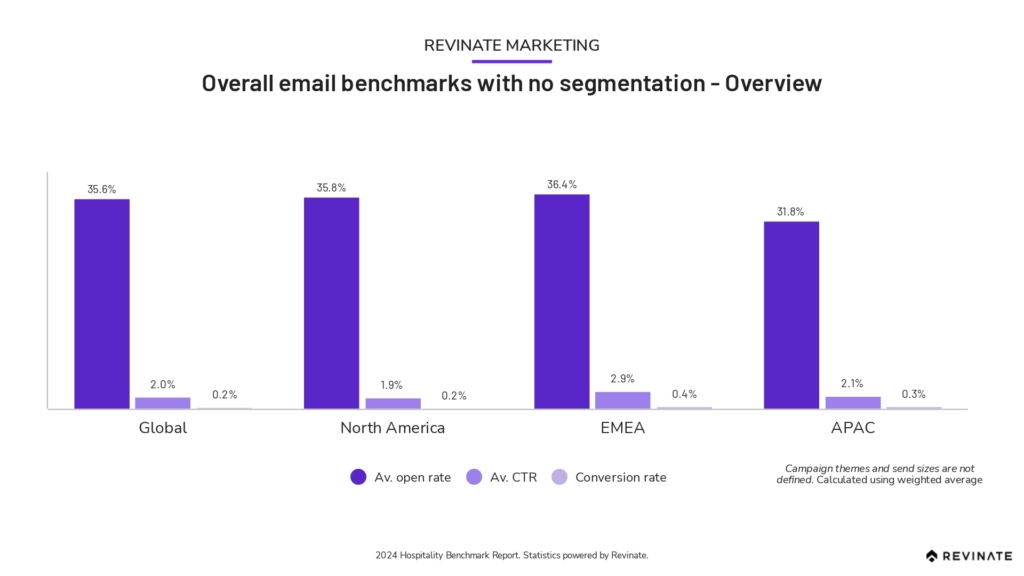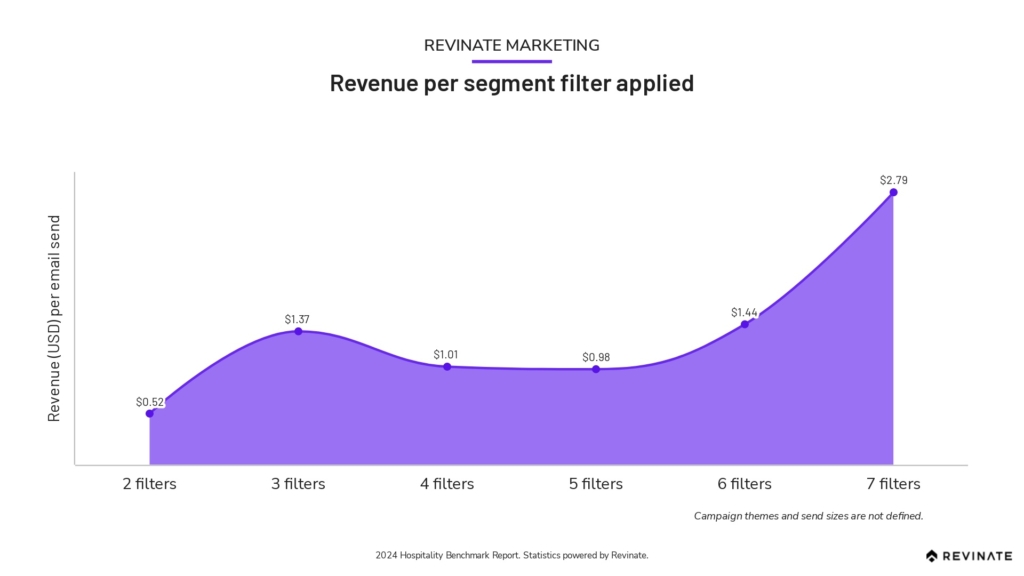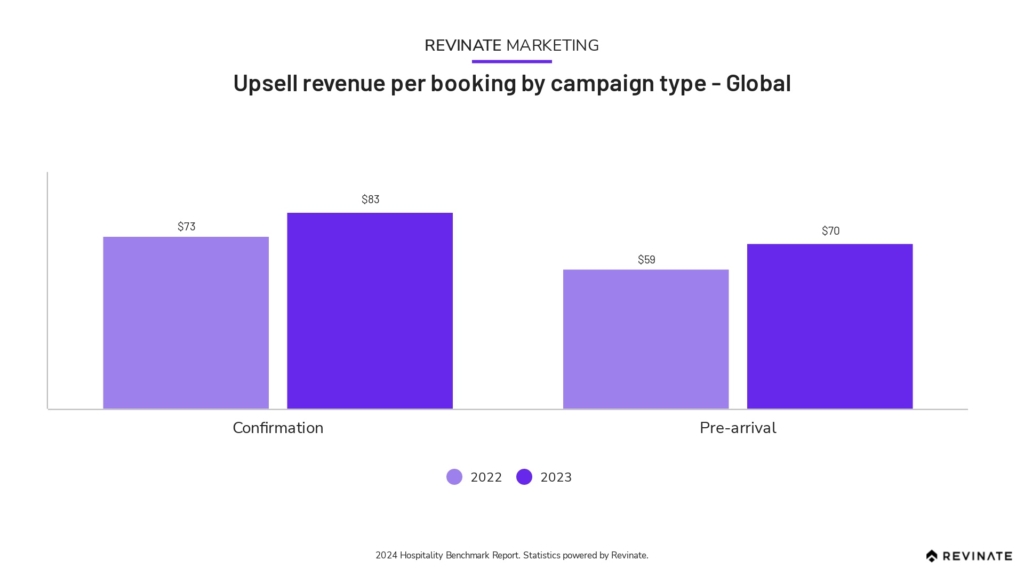10 Hotel marketing KPIs (and how to use them!)
10 Hotel marketing KPIs (and how to use them!)
Behind exceptional hospitality, hoteliers make strategic decisions every day using the best data they have available to continuously improve the guest experience and drive returns for their business.
For hotel operators, tracking data analytics in the form of key performance indicators (KPIs) reveals pathways to optimizing your marketing, customizing guest experiences, and business growth. From understanding how guests discover your property to fine-tuning your email communication, hotel marketing KPIs are the linchpin of your hotel’s success story.
What you will see here
- What is a KPI?
- Website metrics
- Email performance metrics
- Total sales volume and other revenue metrics
- Social media metrics
- Reviews
- Marketing spend
- Customer acquisitions channels
- Front desk feedback
- Customer return rate and loyalty program sign-ups
- Direct bookings mix
What is a KPI?
Key Performance Indicators (KPIs) are measurements that help you gauge how well your hotel is doing in certain areas, like operations and marketing. They’re designed to match your goals, so they give you valuable information about your performance. This information helps you see what’s going well and what needs to be improved.
By leveraging KPIs effectively, you make data-driven decisions that improve operational efficiency and enhance customer experiences — all while maximizing revenue streams.
To help you get started, here are 10 important performance indicators your hotel should be measuring.
1. Website metrics
Tracking web metrics is very important to help you understand how people use your website. This knowledge helps you improve your website and make it more effective at attracting new customers. Most importantly, it can help you get more direct bookings, which gives you an edge over your competitors.
Website sessions
This KPI measures the total number of interactions users have with your hotel website within a specific timeframe. It helps you understand overall website engagement, including the amount of traffic your website generates, and its popularity.
Website conversion rate
Your website conversion rate calculates the percentage of visitors who take a desired action, such as booking a room or signing up for your newsletter. It shows how effective your website is at turning casual browsers and visitors into customers.
The average conversion rate for a hotel website is 2%.
Time on page
The longer a visitor stays on your website, the more likely they are to book with you directly. This hotel marketing KPI tracks the average duration an online visitor spends on specific pages of your hotel website. It indicates user engagement and interest, and it guides improvements in your content, layout, and user experience.
Website search engine rankings
This metric evaluates your hotel’s position in search engine results for specific keywords. Your hotel’s visibility hinges on securing top spots in online searches. Mastering your hotel’s SEO and targeting location-specific searches ensures that you’re visible to the right audience, driving bookings and revenue. It’s particularly important to appear at the top of searches like “hotel in [location]”.
2. Email performance
Email performance metrics are vital for hotels to track because they provide insights into the effectiveness of communication strategies. By tracking appropriate email-related KPIs, you can better target marketing campaigns, enhance guest communication, and customize content for maximum impact, driving higher conversion rates and bookings.
This year Revinate analyzed 1.8 billion emails from our customer data to help hoteliers benchmark their email performance in the 2024 Hospitality Benchmark Report. Use this report to dig deeper on email performance KPIs based on region, campaign type, and more.

Open rate
The email open rate measures the percentage of recipients who open a hotel email campaign. This critical metric provides a window into the effectiveness of your subject lines and overall content, letting you know whether your message is resonating with your audience. It’s useful for identifying the health of your distribution list and targeting.
The global average email open rate for hoteliers, according to Revinate data, is 42.7%.
Email click-through rate (CTR)
Click-through rate, or CTR, measures the percentage of recipients that click on links within your hotel email campaigns. It’s an important metric that indicates the effectiveness of your calls to action (CTAs). A high CTR translates to increased guest interest in specific offerings, driving traffic that leads to higher conversions and bookings.
We found that the global average email click-through rate for hoteliers is 4.2%
Email conversion rate
Your email conversion rate measures the percentage of email recipients that complete a booking after interacting with your email. According to our data, the global average hotel marketing email conversion rate is 0.8%.
If this sounds low, remember that this is the overall average. There is a lot that you can do to increase your email performance metrics and conversion rates by using targeted messaging for specific audiences through hotel guest segmentation.
In fact, you can increase revenue per email recipient by 2.6x on average, according to our benchmark data. Explore the 2024 Hospitality Benchmark Report for more insights and KPIs for hotel email marketing, database health, web capture, the messaging channel, and the voice channel.

Unsubscribe rate
Like your open rate, this metric also serves as a pulse check on the effectiveness and relevance of your content. It reveals the percentage of recipients who aren’t engaging with your messages and opt out of your hotel email communications. By closely tracking this KPI, you can refine your communication plans to reduce opt-outs, ensuring that you retain your subscribers and foster long-term customer relationships.
Deliverability
The email deliverability KPI lets you know if your emails effectively navigate spam filters and successfully reach recipients’ inboxes. A low deliverability rate may result from factors such as a poor sender reputation, or outdated recipient lists lacking proper maintenance. Keeping track of this metric helps you maintain reliable guest engagement by preventing valuable messages from being lost in cyberspace.
3. Total sales volume
Tracking total sales volume KPIs provides insight into your hotel’s financial health and revenue streams. It can help you gauge the effectiveness of your promotional plans, pricing models, and guest communication efforts. These metrics also let you accurately identify your peak and low-demand periods, allowing you to optimize marketing campaigns.
Direct revenue and reservations
These KPIs measure the weekly or regular count of reservations and revenue generated through your hotel website or other owned channels, such as your mobile app or newsletter. It allows you to assess booking trends, revenue streams, and the effectiveness of your direct channels, aiding you in strategizing marketing efforts for sustained growth and profitability.
Average spend per booking
This key metric calculates the average amount a guest spends during their stay at your hotel. It provides a nuanced understanding of guest behavior and spending patterns. It also provides valuable insights into which services or amenities your guests are most inclined to invest in, helping you fine-tune your offerings and revenue-boosting tactics.
Upselling helps you increase average spend per booking, and with the right tools, you can automate the process for an always-on revenue stream.

Channel mix
Your hotel marketing channels are where you interact with your guests and potential guests at various touchpoints along their travel journeys. The channel mix KPI reveals which channels – online travel agencies (OTAs), direct bookings, social media, etc. – yield the highest returns for your hotel. Understanding the percentage of business coming in from different marketing channels allows you to create action plans for an optimal mix based on channel cost. And it allows you to identify any missing market share.
Guest-paid revenue
This KPI helps hotel operators understand the total revenue directly contributed by guests for a booking — whether direct or through a third party. By accurately measuring the revenue guests contribute — as opposed to upcharged room revenue from wholesalers and OTAs — you can strategize pricing models to enhance revenue streams and tailor marketing efforts for continuous revenue growth.
4. Social media metrics
Facebook, Instagram, TikTok… 85% of U.S. consumers use social media, and over half of them follow their favorite brands. It’s becoming increasingly important for hotels to understand and track customer interactions and sentiment over social media. Tracking social media metrics empowers you to measure your brand visibility, and create meaningful connections with guests that can ultimately drive brand advocacy among their connections.
Social sentiment
What are customers saying about you? This metric evaluates the overall sentiment of mentions and comments about your hotel in social media. It reveals how guests perceive your brand online. Understanding this metric can help you shape specific ways to maintain a positive online presence. This is important because positive sentiment leads to a positive online reputation, which ultimately drives brand loyalty and bookings.
Follower growth
Monitoring the growth of your social media following over time reflects the appeal of your engagement strategies, content, and overall brand. A steadily increasing follower count enhances your brand visibility and expands the potential reach of your promotional campaigns.
Social engagement rate
This hotel marketing KPI measures the level of interaction in your social media posts, including likes, comments, and shares. It quantifies the resonance of your posts, helping to guide you in creating more captivating, meaningful, and shareable content. A high engagement rate indicates a strong connection with your audience.
Social media CTR
Just like the CTR on links in your email campaigns, measuring the CTR of users who click on links within your social media posts is also important to measure. It gauges the effectiveness of your CTA strategies, and helps guide efforts for optimizing content and driving traffic. A higher CTR not only enhances guest interactions but also propels potential guests further along the conversion funnel, contributing to increased website visits and bookings.
Social media conversion rate
This metric reflects the effectiveness of your social media marketing in driving real-world actions by tracking the number of social media users who do things like book a room or sign up for promotions after engaging with your social media content.
5. Reviews
Hotel review metrics provide a direct link to understanding guest satisfaction. When you track your review KPIs, you can identify your strengths and areas for improvement. Understanding review metrics isn’t just about getting feedback — it’s a pivotal tool that allows you to enhance your services to maintain competitiveness, increase credibility, and encourage guest loyalty.
Hotel review volume
Your review volume reflects the number of reviews your hotel receives each month. According to our benchmark data, the average hotel review volume increased by 13% globally. Make sure you are proactively asking your guests to leave reviews in order to manage your reputation online.
Review response rate
This rate measures the percentage of guest reviews that your hotel responds to. Responding to reviews helps you build trust and credibility. It showcases your commitment to guest satisfaction, and it influences potential guests by demonstrating that you take a proactive, personalized approach to feedback and continuous improvement. As a best practice, Revinate recommends responding to 100% of negative reviews and about half of positive reviews.
Hotel rating
A high hotel rating directly corresponds to an increase in revenue, according to recent studies. Many factors can impact your rating, including the size and class of your hotel. Explore the web capture section of our 2024 Hospitality Benchmark Report to measure your rating to your peers and set data-informed KPIs.
6. Marketing spend
Marketing spend metrics give you clarity on the effectiveness of your marketing initiatives. They help you optimize your budget allocation by identifying high-performing channels that enhance your visibility and have a positive return on investment (ROI). Keeping track of these metrics help ensure that your marketing efforts achieve maximum impact while maintaining your hotel’s profitability.
Customer acquisition cost (CAC)
Your customer acquisition cost (CAC) is your average cost of acquiring a new guest. This metric helps you reduce expenses by allowing you to determine which marketing channels are the most profitable for attracting customers. The lower the CAC relative to the lifetime value of a customer, the better the success of your marketing efforts.
Return on investment (ROI)
ROI is the most important measurement for your campaign success when your campaign has a specific revenue directive, as opposed to general exposure or top-funnel awareness campaigns. ROI measures the overall profitability of your marketing efforts by considering the total return relative to the cost of a campaign.
Return on ad spend (ROAS)
Different from ROI, return on ad spend (ROAS) is a more specific metric focused on the effectiveness of advertising spend in generating revenue. Keeping close track of this number helps ensure that every marketing dollar you spend contributes positively to your hotel’s bottom line and long-term success.
Impressions and unique impressions
The impressions and unique impressions KPIs measure the respective total and distinct views of your marketing content. Unique impressions count individual viewers, while total impressions include all views, even from the same user. Tracking these metrics help you determine the reach and impact of your campaigns, and guide your targeting strategies to ultimately drive greater engagement and ROI.
Cost-per-click (CPC)
This metric measures the average cost incurred each time a user clicks on your hotel’s ad. Understanding your cost-per-click (CPC) provides valuable insights into the cost-effectiveness of your online advertising, helping you assess ad performance and the efficiency of your paid campaigns. For a complete picture, CPC should always be viewed in conjunction with impressions and CTR for campaigns.
7. Customer acquisition channels
Tracking customer acquisition channels is integral for the success of your business. Insights from this data can guide your marketing strategies, allowing you to refine your outreach efforts and tailor campaigns to capitalize on high-performing avenues. In addition, it’s an effective tool for helping you understand how to craft targeted campaigns that boost lucrative direct bookings.
8. Front desk feedback
Information and feedback gleaned from front desk staff interactions with guests is invaluable data for hotel operators. This information acts as a compass, guiding improvements in the guest experience. Analyzing this data enables you to improve staff training, enhance service quality, and address any gaps in guest knowledge promptly. By focusing on this KPI, you not only help ensure immediate guest satisfaction but garner more positive reviews, and gather key insights for marketing campaigns that encourage repeat bookings.
9. Customer return rate and loyalty program sign-ups
Customer return rate is a valuable indicator of guest satisfaction because it provides insight into your ability to retain customers and create positive experiences that encourage repeat bookings. Coupling this metric with loyalty program sign-ups provides an even better view of the overall picture. This combined data provides insights into guest preferences which you can use to guide beneficial personalized marketing efforts – such as win-back email campaigns – and cultivate brand advocacy for sustained business growth.
10. Direct bookings mix
Tracking your direct bookings mix, including your property’s affiliated brand contribution, reveals the breakdown of bookings that are made directly with your hotel and the percentage received from your brand, versus those through third-party channels. Dissecting your brand contribution gives you insight into the true value of your brand and the effectiveness of brand-driven initiatives. By aiming for high direct bookings, you can work to leverage the strength of your brand to nurture guest relationships directly, reducing your reliance on intermediaries and maximizing revenue.
How to introduce KPIs to your team
To begin implementing hotel marketing KPIs effectively with your staff, it’s best to start by educating teams on the relevance of specific KPIs to their roles and overall hotel success. Transparent communication and regular training sessions are paramount for KPI comprehension. Furthermore, to be truly effective, 95% of leading marketers agree, marketing KPIs must be tied to broader business goals. So, you want to encourage cross-team collaboration in setting measurable goals that guarantee alignment with all your marketing objectives.
Incorporating KPIs within your marketing plan adds precision and accountability. It allows you to consistently assess marketing strategies, enabling real-time adjustments for maximum impact. KPIs serve as performance benchmarks that help guide your teams toward achieving your overarching business goals.
In summary, tracking appropriate hotel marketing KPIs is not just about the numbers. These metrics act as navigational tools, offering invaluable insights for improving guest experiences, enriching marketing strategies, optimizing resources, and boosting overall profitability. By embracing a data-driven approach, you can improve decision-making and achieve greater success in a world where every click, booking, and guest interaction shapes the path toward business growth and excellence. Use our 2024 Hospitality Benchmark Report to find relevant guide posts to set your individual KPIs.
Related Posts
This site is protected by reCAPTCHA and the Google Privacy Policy and Terms of Service apply. View our Terms & Conditions here. *Required fields.



